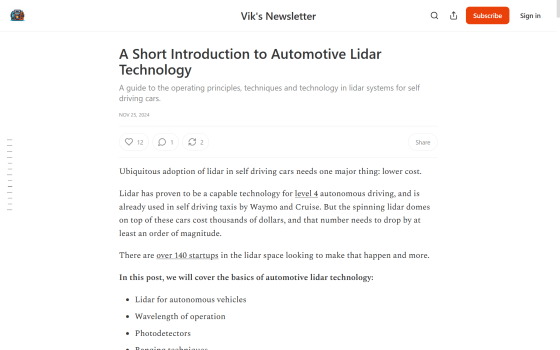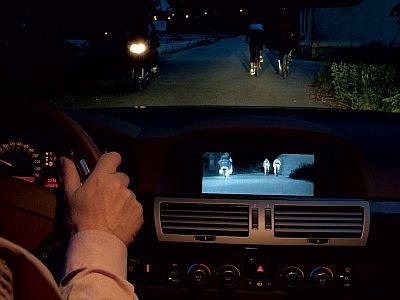How does LiDAR, the tool that allows robots and self-driving cars to understand their surroundings, work?

Source:
LiDAR, a scanning system that helps understand the surrounding situation, is used in a variety of fields, including autonomous driving technology that requires processing according to the surrounding situation, autonomous robots, and 3D applications that scan the surroundings. Vikram Sekhar, an engineering specialist, explained how LiDAR works.
A Short Introduction to Automotive Lidar Technology
https://www.viksnewsletter.com/p/short-intro-to-automotive-lidar

LiDAR stands for Light Detection And Ranging, and is a method of measuring the distance to distant objects using infrared laser light. The technology is not new and has been used for many years in a wide variety of applications, including vegetation study, urban topography, hidden archaeological sites, architecture, and augmented reality imaging.
What makes LiDAR particularly great is that it can produce much higher resolution images than existing radar technology. LiDAR and radar essentially work in a similar way, except that while radar uses microwaves (wavelengths of 1cm to 1m), LiDAR uses laser light (wavelengths of 380nm to 750nm).
LiDAR primarily uses the infrared region of the electromagnetic spectrum and is designed to operate at wavelengths of either 905nm (near infrared) or 1550nm (shortwave infrared). The choice of which to use depends on the power output of the laser source, the sensitivity of the detector, and interference from natural and artificial light sources in the same spectrum, especially sunlight.
There are concerns that the 905nm wavelength is easily absorbed by the retina and may cause damage with long-term exposure, so strict safety standards are in place. Although these wavelengths are more likely to interfere with sunlight and car headlights, the 905nm band tends to be preferred because shorter wavelengths generally have higher sensitivity for photodetectors and allow for more powerful and cheaper light sources to be used. For example, a company called Ouster has patented a LiDAR that improves visibility in wet environments, and is developing an 850nm LiDAR, despite the strong interference from sunlight.
On the other hand, the 1550nm wavelength reduces some of the issues: there is less interference from solar radiation, and this wavelength is less likely to damage the eye as it only penetrates up to the cornea. This means that more power can be used for a longer period of time, allowing detection over a longer range. The disadvantage of the 1550nm wavelength is that it is difficult to use in moist environments due to its high absorption by water vapor.

Source:
LiDAR performance depends on the light source as well as the accuracy of the detector.
The most commonly used detector is the avalanche photodiode (APD) . APDs are often made of materials such as silicon, germanium, or indium gallium arsenide, and each material has a different response to wavelengths. For example, silicon APDs respond well to near-infrared light and are inexpensive to manufacture, while indium gallium arsenide APDs respond well to shortwave infrared light but are expensive.

Detecting the distance to an object using LiDAR is called ranging, and there are two commonly used approaches.
The first method is called 'direct time-of-flight (dToF)' and is similar to bat
The second is 'Frequency Modulated Continuous Wave (FMCW),' which modulates the frequency of the transmitted signal. It also transmits a signal and detects the reflected signal, just like dToF, but measures distance by detecting the frequency difference of the signal instead of time.
FMCW LiDAR systems have the disadvantage of being complex to implement, as they require a tunable laser source for modulation and additional electronic circuitry to extract information from the transmitted and received signals. However, they have the advantage of being less susceptible to interference from other LiDAR systems, as the frequency of the emitted signal can be changed as desired, and the maximum laser power is lower than that of dToF, protecting the human eye, especially at 905 nm.

One of the LiDAR systems that is actually installed in self-driving cars is called a 'mechanical lidar system.' This system uses an infrared laser mounted on a motor and rotates the sensor to ensure a 360-degree horizontal field of view, eliminating blind spots and scanning the surroundings. Google's self-driving taxi 'Waymo' uses this system, but it has the disadvantage that it is expensive because precision parts are required to make the motor and it is subject to wear and damage from repeated rotation.

There is another system called 'MEMS mirror lidar,' which scans the surrounding environment by reflecting laser light off a small mirror, and has the advantage of being able to be implemented at a lower cost than mechanical lidar systems.
LiDAR has proven to be an effective technology for high levels of automation and is used in self-driving taxis by Waymo and Cruise, but the mechanical lidar systems used by both companies cost thousands of dollars, and at least 140 startups are trying to bring the cost down.
Related Posts:
in Vehicle, Posted by log1p_kr







